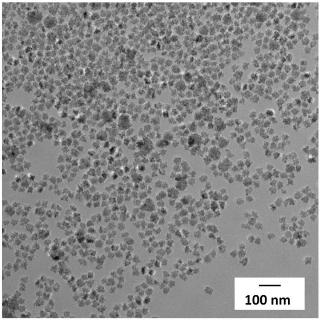Mar 4 2015
Thanks to the work of an interdisciplinary team of researchers at the Dartmouth Center of Nanotechnology Excellence, funded by the National Institutes of Health, the next-generation magnetic nanoparticles (MNPs) may soon be treating deep-seated and difficult-to-reach tumors within the human body.
 Transmission electron microscopy images of Dartmouth's flower-like magnetic nanoparticles are shown. CREDIT: Shubitidze
Transmission electron microscopy images of Dartmouth's flower-like magnetic nanoparticles are shown. CREDIT: Shubitidze
Though the researchers caution that any new therapies based on their discoveries will have to prove safe and effective in clinical trials before becoming routinely available for people with cancer, they point to the work they published this week in the Journal of Applied Physics, from AIP Publishing, as significant progress.
They created a new class of flower-shaped magnetic nanoparticles with superior performance in low-level magnetic fields and worked out their heating mechanism. The work provides future suggestions for developing a new generation of irregularly shaped magnetic nanoparticles for hyperthermia cancer therapy.
What is clinical hyperthermia? It's a technique in which the temperature of a part or the whole of the body is raised above normal. Heat is known to damage or destroy cancerous cells, but to harness it safely and effectively, heating must be applied very specifically and the tumor must be kept within an exacting temperature range for a precise period of time.
One way to achieve this is to administer nanoparticles and then heat them with energy from light, sound or alternating magnetic waves. This is no easy task because the applied alternating radio-frequency waves also generate unnecessary heating in normal tissues. "To date, most commercially available particles designed for the application of hyperthermia heat very well in a relatively high frequency, strong magnetic field," said Fridon Shubitidze, associate professor of engineering at Dartmouth College's Thayer School of Engineering. "However, there is a limit to the frequency and strength that can be applied."
When the human body is placed in a high frequency and strong alternating field, it begins to warm up and, if left unchecked, this could damage normal cells. "One way to avoid damaging normal tissue is by gaining a deeper understanding of the magnetic nanoparticles' heating mechanisms and using this knowledge to create magnetic nanoparticles that heat at low field strengths," Shubitidze pointed out.
In general, bulk magnetic materials heat when they experience a changing magnetic field. "When shrunken down to nano size, these materials can heat in a few different ways that don't occur on a larger scale," explained Shubitidze. "Some involve motion, with the particles physically rotating and/or moving under the influence of the field, while others are entirely non-mechanical and only involve changes in the direction in which the particles are magnetized."
Overall, magnetic nanoparticle hyperthermia consists of two main steps: delivery and then activation of nanoparticles inside tumor cells. Once the magnetic nanoparticles are delivered inside tumor cells, the system activates an electromagnetic field that transfers energy to them, creating localized heating to destroy the tumor cells.
"The local temperature is directly related to the magnitude of the alternating magnetic field at the tumor," Shubitidze elaborated. "The alternating magnetic field from a coil decays rapidly, so to apply this technology in cases involving tumors deep within the body--such as pancreatic cancers--achieving a high-amplitude alternating magnetic field in the tumor necessitates an even higher amplitude alternating magnetic field at the surface. This high magnitude field can also elevate the temperature in normal tissues and limits applicability of magnetic nanoparticle hyperthermia therapy by not getting enough heat out of the particles, which are in a tumor deep within the body."
The particles designed, synthesized and tested by the team show improved performance at low field levels compared to their commercially available counterparts.
This marks a significant step toward "enabling treatment of tumors that are deep within the body," said Shubitidze. "The mechanism of the heating is dictated by various factors such as nanoparticle shape, size, material type and influence of the surrounding environment. Analyses showed that in addition to possible hysteresis heating, the power loss mechanism for our magnetic nanoparticles is magnetic-field-driven viscous frictional loss, which was not previously considered within the magnetic nanoparticle hyperthermia research community."
In terms of applications, magnetic nanoparticle hyperthermia proves effective when there are enough particles in the tumor, when the particles have favorable heating properties, and when a sufficiently strong magnetic field is delivered. The technology can be used as a standalone therapy or as an adjuvant therapy along with chemo and radiation therapies for cancer treatment.
The development of magnetic nanoparticles that heat at lower field levels is an "important step toward making magnetic nanoparticle hyperthermia a clinically viable treatment for deep-seated cancers," Shubitidze noted.
What's next for the team? "We're currently working to combine our magnetic nanoparticles and a new device to deliver a higher field strength to the tumor in the case of pancreatic cancer, which is a particularly difficult target for conventional field generating devices," said Shubitidze.